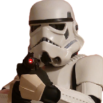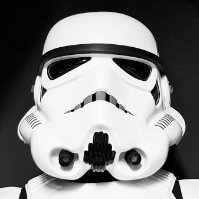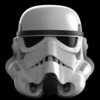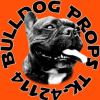-
Posts
30 -
Joined
-
Last visited
-
Days Won
2
About Hideya

Profile Information
-
Gender
Male
-
Location
Kobe City, Japan
Standard Info
-
Name
Hideya
-
501st Unit
Japanese Garrison
Recent Profile Visitors
1,013 profile views
-
Brian, Yes, this build was made from shells ! It’s very satisfying to have electronics for pew pewing but I’ve learned it sometimes is best to keep quite soundwise along with other troopers. Pew pewing is not always necessary or rather sometimes NOT recommended at certain situations. I’m glad if I was able to give some inspiration for the shells!
-
Thanks ! I believe it all depends on what you want, whether it be accuracy, troopability, budget etc and/or combination of these. Mine just happened to be having FUN with minimeal cost, tools and DIY. I'm very interested in the Rubies' E-11. I'll be looking forward in seeing your future E-11 builds. Cheers !
-
Some more photos. Muzzle and front sight was replaced with DIY'd one. Here's the original and modified side by side. Yes, I couldn't help myself from buying another clean original Disney Blaster. I'm going to keep this as it is because why not ? Comparison of the right side. Side by side comparison. This build was completed with only the basic tools and material I had. No resin parts, no printed parts. Just styrene plates, epoxy putty, sandpaper and patience. Hoping this may become some reference to anyone looking for a inexpensive reasonable and fun build.
-
Thank you ! The light weight makes this my favorite E-11 to carry around. I originally thought of having weights inside to make it heavier but I'm glad I didn't. I had a lot of fun with this build and what surprised me was that this Disney Blaster looks good just by painting it only black without the mods. Level of mods you can do depends on you. Let me upload some more pics I've taken of the original and modified one for comparison.
-
So here's the completed Disney E-11 Blaster modification. So here's the original. and then the modified blaster. Original again, and the modified one. More photos. I know it's missing the power cylinder, rear end cap design among others but I'm satisfied as it is and I'm calling it complete for this build. It weighs only 340 grams so it's super troopable. It won't bother you even when it's in the holster.
-
This is how I applied Turner's texture paint. Photo is actually from another E-11 project of mine but is the identical procedure. Got an old sponge from the kitchen and just kept dabbing a small amount of the paint onto a small area and keep dabbing till it's almost dry. Then repeat the procedure again and again till it covers with entire area. I found this worked the best for me. I recommend testing various amounts and procedure on a scrap material till you find the finish you like. Mine turned out like this. Again this photo is from another project but I think you get the idea.
-
Electronics of the Disney blaster is simple yet quite impressive. Both great light and phew phew sounds, stun as well. All in a compact package. I would recommend hot gluing the soldering points of the wiring become they tend to break off every now and then. I also found it challenging trying to get the desired sound and volume when used in another project. Inside construction of Disney blaster may look very rudimentary but this open cavity is what make the Disney blaster sound so good with such a cheap looking speaker. I experimented with various speakers and placement. Hope you have fun. I certainly did!
-
Thanks for coming by. Motivation for my builds came from seeing everyone's great builds. I figured I just might be able to give and share some of the inspiration back to everyone by posting on the FISD. I also enjoyed your Hyperfirm review.
-
T-Tracks were made by gluing together 1mm thick styrene plates. The tips were heated with a lighter and bent into position in the holes of the outer barrel. There were several T-Tracks which burnt up and shriveled being too close to the light flame. I simply made another and tried again till I got it right. Muzzle was made from layering several sheets of styrene sheet and carefully cutting and sanding to a round shape I wanted. Hex bolt was installed in the muzzle for a realistic look. Hengstler counter was DIY'd from styrene plates entirely. For the numbers in the rear, I scavenged the inner parts from an actual counter from a 100 yen shop and glued it in the newly made counter. Here's the blaster during the primer. Aluminum scope rail is not yet install in the photo. The long slot in the receiver was cut out by repeatedly scribing the surface of the receiver with a ruler and box cutter.
-
Hideya started following Hideya's Disney E-11 Blaster Modification
-
Hi everyone. Here's my modification of the Disney E-11 blaster. After seeing the various Disney blaster builds on FISD and seeing how much fun they were having with this very inexpensive, practical, yet quite accurate (?) blaster , I decided to try it myself. I started the build back in February 2020 and took about a month. Even after all the trooping and transportation and drops, it's still in good condition and is still my trusty side arm! My rules were : 1. Use only the basic tools and material I have. Keep it reasonable. 2. DIY extra parts if necessary. No resin parts, no waiting for any package to come. 3. Scavenge the electronic for another project. No pew pew on this build. 4. E-11 Reference guide and everyone's build was very much studied but accuracy not important so much. 5. Have fun. The blaster was about Japanese Yen 2,500 on the net, which was the original retail price. (approx US$20), They no longer sell it at Disney but they still pop up on the net every now and then so it is still available if patient. At least in Japan where I live. Anyway here's the Disney blaster. Here's the blaster taken apart. Electronics were taken out for another project. Muzzle, magazine well, Hengstler counter sawed off with a rotary tool. This was to start with a clean receiver which I would reattach the parts later. Remaining T-tracks shaved off, holes on the outer barrel manually drilled. The gaping hole where the Hengster and scope was fused together and sawed off were patched up with styrene board/ epoxy putty / normal Tamiya putty. The scope was missing a quarter of the body because it was take apart from the receiver. Same materials and procedure was used to close up the gaping hole as well. After all the patch up work, then lots of shaving with a box cutter, metal file, sand paper and patience cleaned up the surfaces. Henglster in the photo was scrapped and swapped with a DIY one in the end. Inside painted matt black. Here's a close up of the patch up job of the parts. Finally ready for painting. Typical of my project, Tamiya's rattle can was mainly used. Gray Tamiya surfacer, then Tamiya's matt black, then Turner's iron colored texture paint and Tamiya's matt black as final coat. Tamiya's semi gloss clear was sprayed to keep the surface consistent.
-
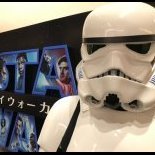
Asahi Airsoft Sterling E-11 Conversion with a Blast-FX
Hideya replied to Hideya's topic in ANH BlasTech E11
I originally thought I needed to punch a hole through the scope body but I'm glad I didn't. Here's how the LED for the scope display and laser is routed from the Henglster through the base of the scope. I'll need to paint it black later but there's no knowing of the wirings at a first glance. Thanks for all your support on this build. Keep in touch ! Hope to be able to join you in the future trooping. -

Asahi Airsoft Sterling E-11 Conversion with a Blast-FX
Hideya replied to Hideya's topic in ANH BlasTech E11
Thanks everyone for your patience on this build. Here is the competed E-11 converted from an Asahi Airsoft Sterling with the Blast-FX and the gorgeous Bulldog's scope installed. Here are the photos with the metal folding stock extended which was one of the main points of using an Asahi Airsoft Sterling. It took me approximately one months for the build. It weighs 1.2 kilo so gives a good realistic and rugged feel of a weapon while not too heavy for trooping. Being able to install the Blast-FX and Bulldog's scope was definitely a charm for me. Couldn't have it done without the generous support from Blast-FX and Bulldog. It was quite challenging but I'm very happy how it turned out. I've yet to make the power cylinder but that'll be done at a another time since I'm currently busy having fun "pew pewing" with the E-11. Cheers. Hideya, TK 93800 of Japan Garrison -

Asahi Airsoft Sterling E-11 Conversion with a Blast-FX
Hideya replied to Hideya's topic in ANH BlasTech E11
As mentioned before, installation of the Blast-Fx was a trial and error. But once I decided on the routing of the wirings and which component to solder back later, it became a whole lot easier. Installation itself is quite simple and straight forward with all the cable length sufficient. Blast -FX main board was installed in the magazine well with detachable magazine to enable easy access to the mini SD card. Counter LED, 3.7v lipo battery, selector main menu switch was routed from the magazine well to the empty Hengstler counter. Rear end of the counter was attached with magnet to allow easy replacement of battery. On/Off switch was installed in the Hengster as well. Battery was connected with a easy detachable connector so it can be swapped if need to. Wirings for scope LED and laser LED was also routed from the magazine well, through the Hengstler and to the bottom hole I made under the scope rail and scope foot. Hope the photos reveal how I did it. This shows where all the wiring is taken out from the magazine well to the Henglster. Total of 5 sets of wiring is bundled up and wrapped with black cloth. I'm quite proud I was able to hide the wiring this way. I would imagine other builds would have the wirings fed out from the receiver but was not possible to the construction of the Asahi airgun. Anyway, here it is. Next upload will be the completed E-11 as of now. -

Asahi Airsoft Sterling E-11 Conversion with a Blast-FX
Hideya replied to Hideya's topic in ANH BlasTech E11
The original Asahi airgun did not have a end cap clip so it was made from styrene plates again. I didn't bother to get the correct dimensions but comparing with reference photo's, it was good enough for me. Yes, I installed a cut up spring from a ball point pen so it's a working clip. And here's what happened to the selector switch. The rotary selector switch supplied with the Blast-Fx was way too long, so it was sawed off till just a few millimeters of the knob was protruding from the grip. Then made a metal lever switch which would fit nicely with the selector. Scrap metal that was lying around was used, and covered up with plastic and epoxy putty to resemble the actual one. In the meantime, I replaced a mock bolt on the grip with a real one I had lying around. -

Asahi Airsoft Sterling E-11 Conversion with a Blast-FX
Hideya replied to Hideya's topic in ANH BlasTech E11
Now with the painting completed, I was finally able to start installation of Blast-FX. I repeatedly went over Blast-FX facebook tutorials and builds on youtube, trying to imagine how it should be installed. There were many helpful ideas but it was still tough since there seems to be numerous ways and logic for each and every build. Not being able to find any builds for the Asahi airgun, which mine was another worrying factor. Such was the situation, the installation process was very much a trial and error process which involved numerous assembly and disassembly of the various parts. It was good that I had intentionally had most of the parts screwed in or bolted on for easy access. Anyway, my points in the installation are; 1. Blast-Fx main board in the magazine well and magazine. Magazine was detachable by the working release button to enable easy access to mini SD card. 2. Speaker in far rear of receiver with a short pipe to amplify sound. 3. Barrel LED strip was wrapped with wax paper from the kitchen for even distribution of light and then wrapped with transparent file folder material to keep it straight in the barrel. 4. Counter LED, menu button and battery cable was pulled through from a hole in the magazine well to the front of the Henglster counter. 5. Rear end of Henglster was attached with small magnet so the lipo battery in the empty Henglster can be easily replaced. 6. Scope LED wiring was pulled from the magazine well, through the Henglister and then outside to the underside of the rail, which was then pulled through a hole in the rail and scope feet so that wires were not visible from outside. Of course, the scope LED was soldered on later. 7. Laser was originally installed in the muzzle in front of the tri-cree. However the tri-cree behind the laser did not shine through as originally imagined so the Laser was eventually installed in front of the scope. 8. Rotary selector was installed in the grip by drilling a large hole in the grip and covering it with epoxy putty. 9. Trigger switch was attached to the original airgun metal trigger along with the original airgun trigger spring. I was able to retain the heavy airgun trigger feel. Here's the initial installation checking the wiring route and length of the wiring. See that the bolt is not yet inserted. It also show the large opening where the grip will be connected to the inner bolt. Yes, the pivot for the stock is metal and bolted to the receiver for a robust connection. Bolt is inserted into the receiver and trigger switch attached to the bolt. The bolt is connected to the receiver with screws hiding beneath the rail Rotary selector embedded into the grip with epoxy putty. Selector was way to long so I had saw it off. View from top of the grip. Rotary selector wiring goes up from the grip into the receiver and then to the Blast-FX main board in the magazine well. Barrel LED strip wrapped with wax paper from the kitchen for even distribution of light and then wrapped with transparent file folder material to keep it straight in the barrel. This was how the tri-cree was attached to the rear end of the muzzle. Matching holes through the rail and scope feet for the scope LED cable I forgot to take photos of Bulldog's beautiful scope installation but the Scope LED of the Blast-FX fitted into the scope like a charm as I believe the inner adapter was specifically made for the Blast-FX. Great job. Laser LED which was originally intended for the muzzle was eventually routed through the front of the scope was a simple and easy installation as well since Bulldog's scope was completely hollow inside. Bullldog's scope is highly recommended not only for the intricate attention to detail and construction but for the installation as well.


